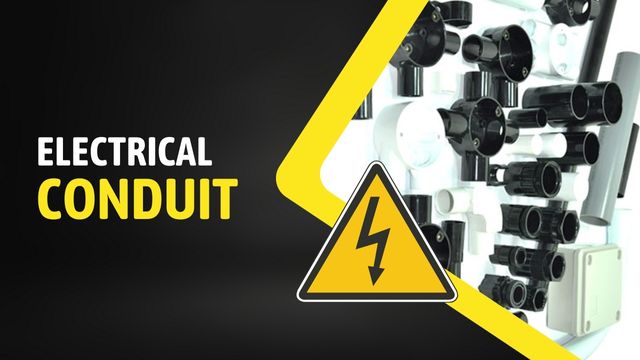
Ever tackled a home electrical project? If you’re planning to add some new outlets or upgrade your wiring, you’ll likely need electrical conduit. But before you dive in, you might be wondering: how much will it cost?

Electrical conduit is like a protective highway for your electrical wires. It shields them from damage and keeps everything safe. Electrical conduit plays a vital role in protecting and routing electrical wiring throughout a building. Whether you’re adding new lighting fixtures, setting up a home office, or undertaking a large commercial build, knowing the cost to run electrical conduit helps you plan more accurately and avoid financial surprises.
In this blog post, we’ll delve into the various aspects of running electrical conduit, from the types available and the factors that influence the overall cost, to providing average price ranges and offering practical tips to save money. By the end of this guide, you’ll have a clear understanding of what to expect and how to manage your budget effectively for any electrical conduit installation project.
Table of contents
What Is Electrical Conduit?
Electrical conduit is a tube used to protect and route electrical wiring in a building or structure. It serves as a safeguard against damage, moisture, and other environmental factors that could potentially harm the wiring. Conduits are essential for maintaining the safety and integrity of electrical systems, particularly in areas where the wiring might be exposed to physical damage or harsh conditions.
Types of Conduit
- PVC (Polyvinyl Chloride) Conduit:
- Description: Lightweight, non-metallic, and resistant to corrosion and moisture.
- Uses: Ideal for underground installations, outdoor use, and areas with high moisture levels.
- Metal Conduit:
- Rigid Metal Conduit (RMC):
- Description: Thick-walled, heavy-duty, and provides excellent protection against physical damage.
- Uses: Suitable for industrial environments and areas where the conduit is exposed to potential impacts.
- Electrical Metallic Tubing (EMT):
- Description: Thinner and lighter than RMC, easy to bend, and provides moderate protection.
- Uses: Commonly used in commercial buildings and indoor applications.
- Flexible Metal Conduit (FMC):
- Description: Flexible, easy to install in tight spaces, and provides moderate protection.
- Uses: Used in areas requiring flexibility, such as connecting appliances and fixtures.
- Flexible Non-Metallic Conduit (FNC):
- Description: Flexible, lightweight, and resistant to moisture and chemicals.
- Uses: Ideal for indoor applications where flexibility and easy installation are needed.
Uses of Electrical Conduit
- Residential Settings: Protects wiring in homes, particularly in basements, attics, and outdoor areas.
- Commercial Buildings: Ensures safety and organization of wiring in offices, retail spaces, and industrial facilities.
- Special Applications: Used in environments with specific requirements, such as hospitals, laboratories, and areas with hazardous materials.
Understanding the different types of conduit and their uses will help you choose the right materials for your project. Each type has its own cost implications, and selecting the appropriate one is crucial for both safety and budget management. In the next section, we will explore the factors that affect the cost of running electrical conduit.
Factors Affecting the Cost
Several factors influence the overall cost of running electrical conduit. Understanding these factors can help you plan your budget more accurately and make informed decisions for your project.
1. Type of Conduit:
- Material Cost: Different types of conduit materials have varying costs. For example, PVC conduit is generally cheaper than metal conduit, but it might not be suitable for all environments.
- Durability and Application: The choice of conduit depends on the specific needs of your project. Heavy-duty metal conduit might be necessary for industrial applications, while flexible non-metallic conduit might be sufficient for residential use.
2. Length of Run:
- Total Length Required: The more conduit you need, the higher the cost. Measure the total length accurately to avoid buying excess material.
- Distance and Routing: Longer distances and more complex routing, such as around corners or through walls, will increase the amount of conduit needed and, consequently, the cost.
3. Installation Complexity:
- Difficulty of Installation: Simple, straight runs are easier and cheaper to install. Complex installations that require multiple bends, fittings, and adjustments will take more time and effort, increasing labor costs.
- Obstacles and Accessibility: Hard-to-reach areas, existing structures, and obstacles can complicate the installation process, leading to higher costs.
4. Labor Costs:
- Professional Installation: Hiring an electrician or a professional installer adds to the overall cost. Labor rates can vary based on the region, the complexity of the job, and the experience of the installer.
- DIY Installation: Doing it yourself can save on labor costs, but it requires the right tools, knowledge, and adherence to safety standards. Mistakes can lead to additional expenses.
5. Additional Materials:
- Fittings and Connectors: You’ll need various fittings, connectors, and support brackets to secure the conduit in place. These add to the material costs.
- Other Supplies: Additional supplies like screws, clamps, and adhesives may also be required, depending on the installation.
6. Location:
- Regional Price Differences: The cost of materials and labor can vary significantly by region. Urban areas might have higher costs compared to rural areas.
- Local Building Codes and Permits: Some locations have specific building codes and permit requirements that can add to the cost. Ensure compliance with local regulations to avoid fines and rework.
By considering these factors, you can better estimate the cost of running electrical conduit for your specific project. In the next section, we will provide average cost ranges to give you a clearer idea of what to expect.
Average Costs
Knowing the average costs involved in running electrical conduit can help you create a realistic budget for your project. While actual costs can vary based on several factors, having a general idea of the price ranges can be beneficial. Here, we’ll break down the costs into material and labor, and provide a rough estimate for typical installation projects.
Material Costs:
- PVC Conduit:
- Cost: $0.30 to $1.00 per foot
- Use: Cost-effective for residential and outdoor use, particularly where moisture is a concern.
- Metal Conduit:
- Rigid Metal Conduit (RMC):
- Cost: $1.50 to $3.00 per foot
- Use: Ideal for industrial settings or areas prone to physical damage.
- Electrical Metallic Tubing (EMT):
- Cost: $0.50 to $1.50 per foot
- Use: Common in commercial buildings and indoor applications.
- Flexible Metal Conduit (FMC):
- Cost: $0.50 to $1.50 per foot
- Use: Suitable for areas requiring flexibility, such as appliance connections.
- Flexible Non-Metallic Conduit (FNC):
- Cost: $0.40 to $1.20 per foot
- Use: Useful for indoor applications needing flexible routing.
Labor Costs:
- Electrician Rates: Typically range from $50 to $100 per hour, depending on the region and the complexity of the work.
- Installation Time: A straightforward installation might take a few hours, while a more complex job can take a full day or more. For a standard residential project, expect labor costs to be between $200 and $800.
Total Cost Estimate:
- Small Residential Project:
- Example: Installing conduit for an additional outlet.
- Materials: $50 to $100
- Labor: $200 to $400
- Total Estimate: $250 to $500
- Medium Residential Project:
- Example: Wiring a new room or basement.
- Materials: $100 to $300
- Labor: $400 to $800
- Total Estimate: $500 to $1,100
- Large Commercial Project:
- Example: Wiring a new office space.
- Materials: $500 to $2,000
- Labor: $1,000 to $5,000
- Total Estimate: $1,500 to $7,000
These estimates provide a general idea of the costs involved in running electrical conduit. Keep in mind that actual costs can vary based on specific project requirements and regional differences. In the next section, we will discuss some cost-saving tips to help you manage your budget effectively.
Cost-Saving Tips
Managing the cost of running electrical conduit can be challenging, but with some careful planning and smart choices, you can keep expenses under control. Here are some practical cost-saving tips to help you reduce the overall cost of your project without compromising on quality and safety.
1. DIY vs. Professional Installation:
- Assess Your Skills: If you have basic electrical skills and the necessary tools, you might be able to handle simple conduit installations yourself, such as adding an outlet or running conduit in accessible areas.
- Know When to Hire a Professional: For complex installations, like wiring an entire room or dealing with multiple bends and obstacles, it’s best to hire a licensed electrician. Mistakes can be costly and dangerous, so professional expertise is often worth the investment.
2. Bulk Purchasing:
- Buy in Bulk: Purchasing conduit and other materials in bulk can often save you money per unit. If you have a large project or multiple projects planned, consider buying larger quantities to take advantage of discounts.
- Supplier Discounts: Look for suppliers that offer discounts for larger orders or frequent purchases. Sometimes, local hardware stores and specialized electrical supply shops provide better deals than big-box retailers.
3. Plan Efficiently:
- Measure Accurately: Careful measurement of the distances and routes for the conduit can help you avoid buying excess material. Plan the most efficient path for the conduit to minimize the length required.
- Minimize Bends and Fittings: Try to design the conduit run with as few bends and fittings as possible. Each bend and fitting not only adds to the material cost but also increases installation time and complexity.
4. Compare Quotes:
- Get Multiple Estimates: Before committing to a contractor, get quotes from several electricians or installation services. Comparing prices and services can help you find the best deal.
- Negotiate: Don’t hesitate to negotiate the price with contractors. Sometimes, they can offer a discount, especially if you have multiple projects or can provide flexible scheduling.
5. Use Alternative Materials:
- Consider Cost-Effective Options: Depending on the project, you might be able to use a less expensive type of conduit without sacrificing safety or functionality. For example, PVC conduit is cheaper than metal and might be sufficient for certain residential applications.
- Evaluate Recycled Materials: Some suppliers offer recycled or refurbished conduit at a lower cost. Ensure these materials meet the necessary safety standards before using them.
Implementing these cost-saving tips can significantly reduce the expenses involved in running electrical conduit. By planning carefully, making informed choices, and exploring all your options, you can complete your project within budget while maintaining high standards of safety and quality. In the next section, we will provide examples of cost calculations to give you a clearer idea of what to expect for different types of projects.
Examples of Cost Calculations
To help you better understand the potential costs involved, let’s look at two detailed examples of cost calculations for typical projects: a small residential project and a larger commercial project. These examples will illustrate how the factors discussed earlier come together to determine the total cost.
Example 1: Small Residential Project
Project Description: Adding conduit for an outdoor outlet in a backyard.
- Materials Needed:
- 50 feet of PVC conduit ($0.50 per foot) = $25
- 10 connectors and fittings ($1.50 each) = $15
- Grounding wire and additional supplies = $20
- Total Material Cost: $60
- Labor Costs:
- Estimated Time: 4 hours
- Electrician’s Rate: $75 per hour
- Total Labor Cost: 4 hours x $75/hour = $300
- Additional Costs:
- Permit fees and miscellaneous supplies = $25
- Total Project Cost:
- Materials: $60
- Labor: $300
- Additional Costs: $25
- Total Estimated Cost: $385
Example 2: Large Commercial Project
Project Description: Wiring a new office space, including running conduit for multiple outlets, lights, and a main distribution panel.
- Materials Needed:
- 300 feet of EMT conduit ($1.00 per foot) = $300
- 50 connectors and fittings ($2.00 each) = $100
- Grounding wire, junction boxes, and supports = $200
- Total Material Cost: $600
- Labor Costs:
- Estimated Time: 3 days (24 hours)
- Electrician’s Rate: $80 per hour
- Total Labor Cost: 24 hours x $80/hour = $1,920
- Additional Costs:
- Permit fees and inspection costs = $150
- Temporary lighting and power supplies during installation = $100
- Total Project Cost:
- Materials: $600
- Labor: $1,920
- Additional Costs: $250
- Total Estimated Cost: $2,770
Summary of Key Points
- Small Residential Project Total Cost: Approximately $385
- Large Commercial Project Total Cost: Approximately $2,770
These examples provide a practical look at the costs involved in different types of electrical conduit projects. By breaking down the costs into materials, labor, and additional expenses, you can get a clearer picture of what to expect and better plan your budget.
In the final section, we will wrap up with a summary of the key takeaways and encourage you to take action based on the information provided.
Conclusion
Summarizing the key points and offering final insights is crucial for wrapping up the blog post effectively. Here’s how the conclusion will be structured and described:
Summary of Key Points:
- Understanding Costs: Running electrical conduit involves various costs, including materials, labor, and additional expenses. Knowing the types of conduit and their specific uses can help you make informed decisions.
- Factors Influencing Costs: The total length of the conduit run, installation complexity, and regional differences in labor and material costs are significant factors that affect the overall price.
- Average Costs: Providing a general idea of the cost ranges for materials and labor helps set realistic expectations. Small residential projects typically cost less than more complex commercial installations.
- Cost-Saving Tips: Practical tips such as considering DIY vs. professional installation, bulk purchasing, efficient planning, and comparing quotes can help you manage your budget more effectively.
- Examples: Detailed cost calculations for different project sizes give you a clearer understanding of potential expenses and how to budget accordingly.
Encouragement:
- Plan Carefully: Emphasize the importance of careful planning and thorough research before starting an electrical conduit project. Encourage readers to take the time to measure accurately, choose the right materials, and consider all cost factors.
- Consult Professionals: While DIY projects can save money, complex installations often require professional expertise. Encourage readers to consult with licensed electricians to ensure safety and compliance with local codes.
Running electrical conduit is a critical aspect of any construction or renovation project. By understanding the various types of conduit, the factors influencing costs, and practical ways to save money, you can plan and budget effectively for your project.
Remember, accurate measurements, efficient planning, and careful selection of materials are key to minimizing expenses. While some projects can be tackled as DIY endeavors, more complex installations may require the expertise of a licensed electrician to ensure safety and compliance with local regulations.
We hope this guide has provided you with valuable insights and practical tips to help you manage the costs of running electrical conduit. If you have any questions, need further advice, or want to share your own experiences, please leave a comment below. We’d love to hear from you!
For those seeking professional assistance, feel free to contact us or check out our recommended service providers. Happy planning, and good luck with your project!
This concludes the blog post and leaves readers with a comprehensive understanding of the costs associated with running electrical conduit, along with actionable tips and encouragement to take the next steps in their projects.


